This English page is suitable for PC - Tablet - Mobile phoneJoey Miller is the webmaster of the website Jen Reviews
|
Step 1 - Soaking the Salmon: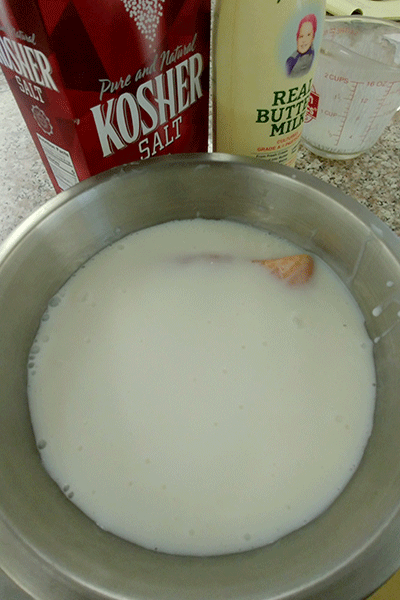
Combine the buttermilk and salt in a non-reactive bowl. Be sure the fish is covered in the liquid. Soak it for 20-30 minutes. Much longer than that, the salmon will become hard and dry. The brine will remove the fishy taste that most people do not like. It will also give the "Gravadlaks" a nice, buttery mouthfeel. You can use plain milk, but buttermilk gives a nice umami taste.
Step 2 - Gently rinse and pat dry: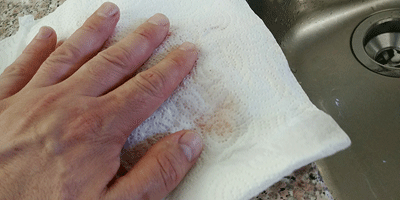
Remove the salmon from the buttermilk brine, carefully rinse in cold water and gently pat it dry with some paper towels. Be careful not to damage the fish.
Step 3 - Make the dry seasoned cure: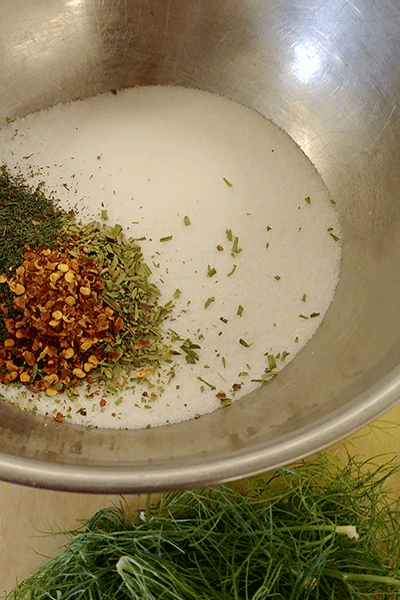
Mix together the salt, sugar, dried herbs, spices and freshly chopped fennel fronds. Set aside.
Step 4 - Line up the cheesecloth: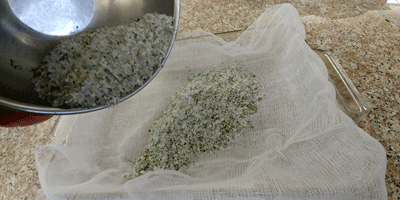
Place a piece of cheesecloth large enough to wrap the salmon in the bottom of a glass baking pan (Any non-reactive pan will do). Pour half of the curing mix onto the middle of the cheesecloth and spread it evenly. You should have about half an inch of cure or so.
Step 5 - Place the salmon on the dry cure mix: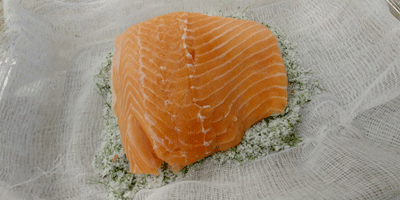
Place the salmon on top of the cure mix.
Step 6 - Add the remaining cure: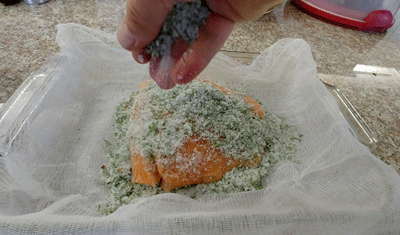
Sprinkle the remaining cure mix on top of the fillet ensuring that it is covered completely.
Step 7 - Wrap the cure mix and salmon filet in the cheesecloth: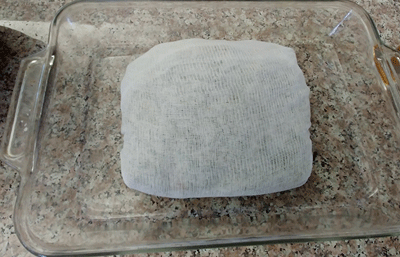
Carefully wrap the salmon with the cheesecloth creating a sort of pouch; flesh side up.
Step 8 - Splash on a little cognac or whisky: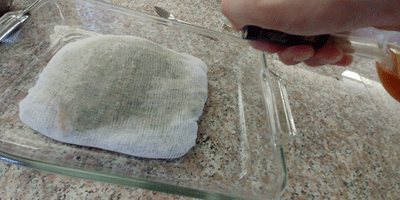
Splash on the cognac or whisky over the flesh side of the salmon.
Step 9 - Top with plastic film and add some weight: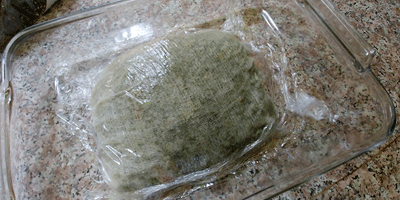
Place a piece of plastic cling film on top of the moistened cheesecloth and place a plate or shallow dish on top with a can inside for weight.
Step 10 - Refrigerate, wait, flip, wait: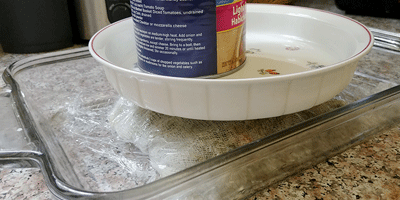
Place the salmon in the refrigerator, flipping it over every 12 hours, replacing the plastic cling film back on the top, replacing the weighted plate. Do this for at least two days.
Step 11 - Wipe off the brine, but do not rinse:
Unwrap the now cured salmon from the cheesecloth. Carefully brush away the cure mix with a paper towel.
Step 12 - Slice and serve: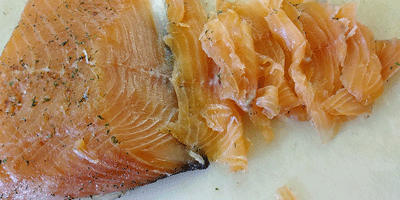
Slice thinly against the grain on a bias and serve. Suggestions are in your favorite warmed bagel smeared with cream cheese, sprinkled with capers, red onion and fresh dill.
|
|
"Gravlax" Recipe for 4 adults
For brine 1 kg salmon fillet from the thickest place 3 to 4 dl buttermilk 2 tbsp. * Kosher salt or coarse table salt For the spice mix 1 tbsp. fennel seeds crushed coarsely 2 tbsp. dried dill 1 tbsp. dried tarragon 1 tsp. white pepper 1 tsp. crushed red pepper flakes (mild chili pepper) 240 g * Kosher salt or coarse table salt 60 g light brown cane sugar 4 cl Cognac or Whiskey, more or less to taste Instructions: Step 1 - Soaking the Salmon: Combine the buttermilk and salt in a non-reactive bowl. Be sure the fish is covered in the liquid. Soak it for 20-30 minutes. Much longer than that, the salmon will become hard and dry. The brine will remove the fishy taste that most people do not like. It will also give the "Gravadlaks" a nice, buttery mouthfeel. You can use plain milk, but buttermilk gives a nice umami taste.
Step 2 - Gently rinse and pat dry: Remove the salmon from the buttermilk brine, carefully rinse in cold water and gently pat it dry with some paper towels. Be careful not to damage the fish. Step 3 - Make the dry seasoned cure: Mix together the salt, sugar, dried herbs, spices and freshly chopped fennel seeds. Set aside. Step 4 - Line up the cheesecloth: Place a piece of cheesecloth large enough to wrap the salmon in the bottom of a glass baking pan (Any non-reactive pan will do). Pour half of the curing mix onto the middle of the cheesecloth and spread it evenly. You should have about half an inch of cure or so. Step 5 - Place the salmon on the dry cure mix: Place the salmon on top of the cure mix. Step 6 - Add the remaining cure: Sprinkle the remaining cure mix on top of the fillet ensuring that it is covered completely. Step 7 - Wrap the cure mix and salmon filet in the cheesecloth: Carefully wrap the salmon with the cheesecloth creating a sort of pouch; flesh side up. Step 8 - Splash on a little cognac or whisky: Splash on the cognac or whisky over the flesh side of the salmon. Step 9 - Top with plastic film and add some weight: Place a piece of plastic cling film on top of the moistened cheesecloth and place a plate or shallow dish on top with a can inside for weight. Step 10 - Refrigerate, wait, flip, wait: Place the salmon in the refrigerator, flipping it over every 12 hours, replacing the plastic cling film back on the top, replacing the weighted plate. Do this for at least two days. Step 11 - Wipe off the brine, but do not rinse: Unwrap the now cured salmon from the cheesecloth. Carefully brush away the cure mix with a paper towel. Step 12 - Slice and serve: Slice thinly against the grain on a bias and serve. Suggestions are in your favorite warmed bagel smeared with cream cheese, sprinkled with capers, red onion and fresh dill. Homemade "Fox Sauce" for "Gravlax": 2 tbsp. Dijon mustard 1 tsp. Colmans Mustard, mustard powder 1 tbsp. white wine vinegar 3 tbsp. farin 2 tsp. soy sauce 1 bdt. Dill 5-6 tbsp. Grape seed oil Blend mustard, mustard powder, vinegar, sugar, soy and clipped dill in a food processor or with a stick blender. Add the oil a little at a time while blending until the sauce has a suitably thick consistency. Season with sugar and serve. NB: Be careful with Colmans Mustard as it is very "HOT". Tip: The file pieces can be frozen before "Gravad", but not after. It may be a good idea to freeze the salmon/trout for 48 hours before "Gravad", as there may be tapeworms in the fish. It is a requirement of the authorities that fish that are not heat-treated must be frozen for 48 hours if the fish is to be used for Sushi. The recipe refers to cheesecloth, but I use the old-fashioned cloth diapers 70 x 70 cm from COOP. They are cheap and very suitable. Just remember to cook them well and thoroughly before use. Cut them to a suitable size for the fish you want to use. *Kosher salt and coarse table salt are almost identical. However, there is a difference, Kosher salt is "invented" in North America by the Jews, so therefore the salt must be "Pure" according to Judaism. The opposite will be Treif "Unclean". Therefore, Kosher salt is not with additives such as iodine, minerals or anti-caking agents. The structure of Kosher salt is flatter. We know it from Læsø Sydesalt. Coarse table salt, as we know it in Denmark, is more pyramid-shaped and can contain additives such as iodine. In some there are anti-caking agents, and maybe minerals? The big difference is the price: Kosher salt ca. 50.00 DKK per kg, Coarse table salt less than 10.00 DKK per kg and Læsø Sydesalt 160.00 DKK per kg. Danish version How to Fillet a Fish the Easy Way – Step by Step Tutorial: by Bradley Labarre. Back to the page where you came from |

one.com |